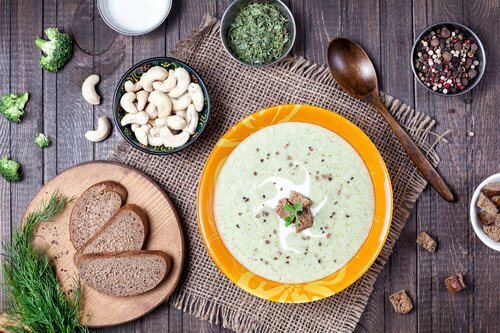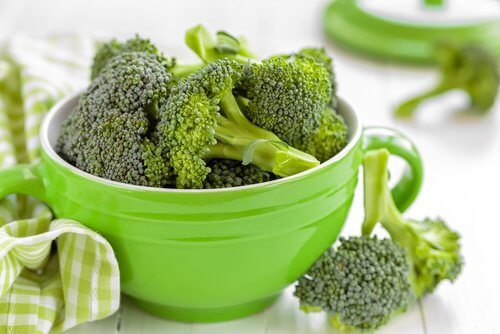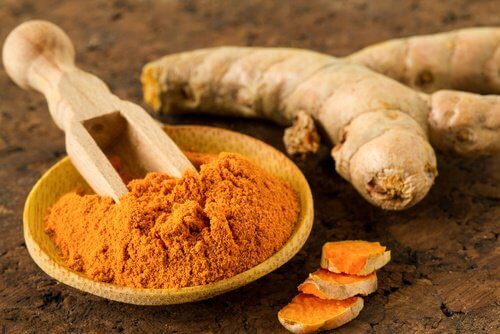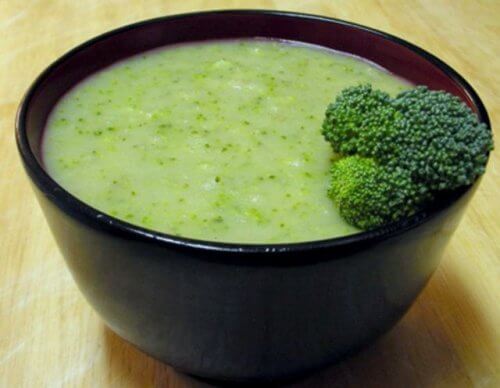Cream of Vegetable Soup for Pain Relief


Reviewed and approved by the doctor Nelton Abdon Ramos Rojas
Did you know you can eat certain types of vegetable soup for pain relief?
There are many people who suffer from chronic pain in some part of the body, whether it’s muscular, in the joints, or related to an organ. Chronic pain can cause terrible amounts of suffering, causing people to take medications that aren’t always effective and that can have side effects for your health.
In today’s article, we want to share a recipe for cream of vegetable soup for pain relief. It has natural anti-inflammatory properties to help you relieve or eliminate your pain naturally.
Foods that Fight Pain Naturally
Certain foods contain nutrients with certain healing properties, and you can take advantage of these to relieve a variety of ailments.
To eliminate pain, you need to combine two main benefits:
- Pain relief: to ease or completely eliminate pain,
- Anti-inflammatory: to reduce the inflammation that could be causing your pain.
The foods listed below not only have these properties – when they are consumed together, it enhances their healing effects.
Broccoli

It also contains cancer-fighting properties, making it a highly recommended food for a vegetable soup for pain relief.
Onions
Onions stand out thanks to their anti-inflammatory and diuretic properties that help fight fluid retention.
Read: Amazing Natural Remedies for Neck Pain
Garlic
Garlic is a powerful medicinal food with excellent pain relieving properties, thanks to its content of capsaicin. This makes it suitable for all types of pain, whether it’s muscular pain, dental pain, or a headache.
Turmeric

- Has many antioxidants.
- It antiviral.
- Has anti-inflammatory properties.
- Is pain relieving.
- Improves liver and gallbladder function.
Overall, it’s a great supplement to prevent or fight any disease. You can use it as a natural yellow food dye in the kitchen, and it adds a touch of unique flavor to your dishes.
You might like: Three Natural Painkillers to Relieve Migraines
Black pepper
Black pepper contains a substance known as piperine, which activates the receptors against pain and also enhances the properties of the curcumin found in turmeric.
Cayenne pepper
Like garlic, cayenne pepper contains capsaicin, which helps to reduce pain.
It’s a very spicy food, however, so start by incorporating it slowly into your diet to avoid any digestive problems. Start by adding just a pinch to any recipe and then you can increase the amount.
Olive oil
Extra virgin olive oil, along with coconut oil, is one of the best options for cooking because it withstands high temperatures so well. Other vegetable oils, on the other hand, break down and can be harmful to your health when they get too hot.
Olive oil is in perfect synergy with turmeric and black pepper, when it comes to preventing and eliminating pain naturally.
Sea salt
We recommend always choosing sea salt over table salt, which is a refined product that lacks nutrients. Sea salt, on the other hand, is rich in minerals and trace elements.
Remember to consume it in moderation, however, to avoid inflammation.
A Cream of Vegetable Soup for Pain Relief
Ingredients
- 1 head of broccoli
- 1 onion
- 4 cups of water
- 2 cloves of garlic
- 1 teaspoon of ground turmeric (5 g)
- 1 teaspoon of ground black pepper (5 g)
- Pinch of cayenne pepper (to taste)
- Olive oil
- Sea salt
 Preparation
Preparation
- First, you’ll need to wash and chop the broccoli and onion, adding them to a saucepan along with the water.
- Then add the whole clove of garlic.
- Heat to a low boil and allow to simmer for 30 minutes.
- A few minutes before cooking is finished, add all the remaining ingredients.
- Blend all of the ingredients once it has cooled slightly, until you obtain a creamy soup with a smooth texture.
- You can enjoy it hot, or consume this soup cold on a warm day.
If you’re having problems with pain, try consuming this soup throughout the day, in addition to your regular meals, for as long as you need to.
All cited sources were thoroughly reviewed by our team to ensure their quality, reliability, currency, and validity. The bibliography of this article was considered reliable and of academic or scientific accuracy.
-
Finley, J. W., Ip, C., Lisk, D. J., Davis, C. D., Hintze, K. J., & Whanger, P. D. (2001). Cancer-protective properties of high-selenium broccoli. Journal of agricultural and food chemistry, 49(5), 2679-2683.
-
Fusco, B. M., & Giacovazzo, M. (1997). Peppers and pain. Drugs, 53(6), 909-914.
-
Hwang, J. H., & Lim, S. B. (2015). Antioxidant and anticancer activities of broccoli by-products from different cultivars and maturity stages at harvest. Preventive nutrition and food science, 20(1), 8.
-
Jurenka, J. S. (2009). Anti-inflammatory properties of curcumin, a major constituent of Curcuma longa: a review of preclinical and clinical research. Alternative medicine review, 14(2).
-
Kempaiah, R. K., & Srinivasan, K. (2004). Influence of dietary curcumin, capsaicin and garlic on the antioxidant status of red blood cells and the liver in high-fat-fed rats. Annals of nutrition and metabolism, 48(5), 314-320.
-
Lobo, R., Prabhu, K. S., Shirwaikar, A., & Shirwaikar, A. (2009). Curcuma zedoaria Rosc.(white turmeric): a review of its chemical, pharmacological and ethnomedicinal properties. Journal of Pharmacy and Pharmacology, 61(1), 13-21.
-
Roldán, E., Sánchez-Moreno, C., de Ancos, B., & Cano, M. P. (2008). Characterisation of onion (Allium cepa L.) by-products as food ingredients with antioxidant and antibrowning properties. Food Chemistry, 108(3), 907-916.
-
Srinivasan, K. (2007). Black pepper and its pungent principle-piperine: a review of diverse physiological effects. Critical reviews in food science and nutrition, 47(8), 735-748.
This text is provided for informational purposes only and does not replace consultation with a professional. If in doubt, consult your specialist.








